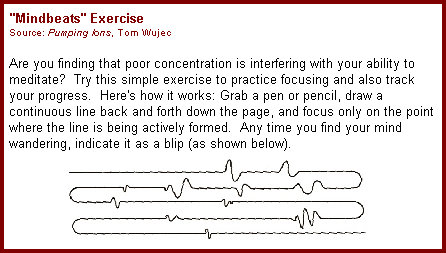Daily Coping Skills, Part 1
At a Glance: Ways to Cope from Day to Day
Tap
into the powers of thought
Positive thinking and visualization
of success are among the many ways to take charge of your mental
and physical health. After all, the body and mind are linked,
so the more you can learn to harness that power, the more influence
you'll have over your general well-being.
Pay attention
to your eating habits
Eating small meals throughout the day,
starting with a healthy breakfast, will help stabilize your blood
sugar, thereby regulating levels of serotonin and dopamine.
Limiting the use of sugar, salt, stimulants (such as coffee, tea,
and cigarettes), and depressants (like alcohol) can help as well.
You might also wish to consider dietary supplements such as vitamin
B-complex, vitamin C, and omega-3 oil. Talk to your doctor before
making any significant dietary changes.
Drink plenty of water
In
addition to regulation of physiological systems and toxin removal,
water supports moods, energy, and overall cognitive performance.
Have at least six 8-ounce glasses of water each day, and don't
wait until you're thirsty before drinking water, since thirst can
be the first sign of dehydration.
Get adequate sleep
Sleep is
the body's time to repair and rejuvenate itself. Lack of sleep
can lead to increased anxiety and irritability, poor concentration,
alterations in mood, decreased ability to cope with stressors, and
a depressed immune system. Individuals vary in the number of
hours of sleep required to function well; however, if you're
unsure of your body's needs, strive to get the recommended 8 hours
of sleep per night (for adults).
Exercise on a regular basis
The
benefits of exercise are too vast to cover in an overview, but they
can help by releasing mood-elevating chemicals (endorphins), enhancing
sleep, and increasing overall health. If you're not in
shape, consult a doctor before beginning an exercise routine, and
be careful not to try to make up all the "lost time" in one week--start
slowly! If you cringe at the thought of hitting the gym or athletic
courts, or you don't have enough energy to do so right now, try adding
little things into your daily life--park farther away from entrances,
take the stairs instead of the elevator, sweep the floors in your
house, etc.
Expose yourself to sufficient light sources
Everyone
is encouraged to get natural sunlight to help lift mood,
but this is especially important for people with a condition called
Seasonal Affective Disorder (SAD). With this condition, your
mood correlates heavily with your amount of light exposure.
To alleviate the symptoms, try opening windows, spending more time
outdoors, and investing in a specially manufactured light box.
Reduce
stress wherever possible
Humans were not designed to cope with
the chronic stresses inherent in present day life--add to that the
stress produced from the illness itself, and you have a recipe for
disaster. Stress has been linked to illnesses including cancer,
heart disease, lung conditions, and suicide. Practicing stress
reduction techniques on a regular basis can help keep this nemesis under
control, thereby improving the quality of your life.
Establish
daily routines
When an illness interferes with life, it can be
easy to lose your sense of control over your environment. Not
only can the creation of a daily schedule help prevent you from slipping
into the vicious cycle of unproductive behaviors, but it can
also help restore a sense of control and comfort in a disorder that
can create chaos at times. The routine can be as simple as taking
a shower when you first wake up or "closing" your days by straightening
up your bedroom and filling out your mood log.
Be
proactive
Take steps to make your days more pleasant. This
could be accomplished by increasing your interactions with people
whose company you enjoy, engaging in pleasurable activities each day,
working on your self-esteem, and not being afraid to ask for what
you want.
Alternatives to Counting Sheep:
Sleeping
Tips
1) Go to bed at a regular time each night.
2)
Use the bed mainly for sleeping--not for work,
reading, television, etc.
3) Avoid long naps during the
day. However, a
power nap (15-30 minutes) can
be helpful in
getting a second wind.
4)
Eat foods rich in the protein "tryptophan," which
boosts serotonin levels in the body. Sleepy
time foods include pasta, turkey, bananas,
cottage cheese, warm milk, herbal chamomile
tea, etc. Avoid caffeine or other
stimulant consumption close to bed time.
5)
Avoid going to bed on a full stomach. Instead,
choose small snacks before bedtime, which cut
any hunger that could prove distracting as you
settle in.
6) Exercise daily, but don't exercise
too close to
bed time.
7) Take
some time to wind down from your day.
Perhaps engage in meditation or soak in a
relaxing bubble bath (perhaps with a drop of
lavendar oil for extra relaxation).
8) Establish a bedtime
routine that acts as a
signal for your body
that it's time to sleep.
9) Clear your mind by jotting
down anything you
wish to remember for the
next day. The
overactive mind will resist
shutting down for the
night.
10) Prepare
your bedroom environment so that it's
relatively
uncluttered, dark, quiet, and on the
cooler
side of comfortable temperatures (since
your
body sleeps best when it isn't overheating).
11) Toss your sheets
in the dryer for a warm fluffy
feel
as you're drifting off.
12) If you find you can't fall asleep,
try doing a light
task (for example,
reading a chapter from a
book) before attempting
to snooze again.
Focus On: T'ai Chi
Emphasizing
patience and relaxation, t'ai chi is a gentle form of the martial
arts, although it looks more like a ballet (since it was developed
in order to disguise martial art movements at a time when such
practices were banned in China). Slow, flowing movements, once
mastered, have the ability to put individuals in a trance-like state.
The emphasis is on energy, balance, posture, and a sense of inner
calmness throughout the body.
Focus On: Yoga
Even though yoga is a way of life,
it is best known as a form of physical exercise, since it aims to
strengthen the body as well as the mind. Yoga postures are assumed
for the purpose of stretching the body,
re-aligning the systems, reducing
tension, and increasing alertness. You'll oftentimes see yoga
being performed on mats placed on the ground, however, yoga can be adapted
for use in smaller areas, even during bus rides.
Breathing Exercises
The Basic
Breath
Close your eyes. Try to calm your mind. Inhale
slowly and deeply, taking the air in through your nose and expanding
your "belly" with air(as opposed to your pushing your shoulders up
as you breathe). Hold your breath for a moment, then, slowly
release the breath through your mouth, again taking your time.
Repeat. The exhalation should last approximately twice as long
as the inhalation.
In With the Good, Out With the Bad
As
you take deep breaths, imagine you are inhaling positive energy and
exhaling the negative. It may even help to "gather" the positive
energy as you breathe by raising your arms to the sides and up above
your head, then upon release of the air, "push" that energy down toward
your belly as you exhale.
Recite Poetry or Use "Mantras"
The
production of sound is dependent upon breath, therefore the use of
poetry or "mantras" (repeated words or phrases, for example, "aum")
can help regulate the pace and rhythm of the breath. It might
be best to find poetry with a clear meter so that the effect is similar
to mantras--creating hypnotic alpha states in the brain.
Meditative
Visualizations
Whether individually created or guided imagery,
visualizations can take the mind to peaceful places. It's a
chance to access sensations such as touch, sound, vision, etc., without
actually physically using them. The following are some examples:
-
Inner Smile: Give yourself permission to smile--internally, if you
prefer. Feel the power of this gesture, how it radiates throughout
your entire body. Does it feel like a tingling calmness spreading
throughout your being? Does it feel more like light eminating
from within?
- The Wishing Well: Reach into your pocket and take
out a coin of your choice. Move it around in your hand. What are
it's size, weight, and texture like? What color is it,
and is it a traditional coin, or a special coin? Walk over to
a fountain you see in the distance and take in the sights and sounds
of the dripping water. Make a wish, and toss your coin into
the fountain for good luck, paying attention to the ensuing ripples.
Spend some time at the fountain throwing as many coins in as you desire.
-
Take a Vacation: Let your mind take a trip to a peaceful location--this
can be anything from a tourist destination to an imaginary
garden. Engage all of your senses while on this journey and
encourage a peaceful mindset. After all, there are no airline
flights or long ticket lines that we need to encounter during this
vacation.
Man's Best Friend: The Benefits of Pets
Although no
official study has demonstrated
WHY pets add to our well-being,
ask anyone with a furry friend if his or her life would
be complete without a pet, and you'll get an almost definite "Absolutely
not!"
With their friendly personalities and unconditional
love, pets help us by lowering our blood pressure and cholesterol,
building self-esteem, enhancing social skills, and reducing loneliness, anxiety, and
depression.
If you don't have the option of owning a pet, consider
the following:
- visiting or working in a pet store or animal
shelter
- offering a dog walking/washing service to
neighbors
-
participating in pet therapy sessions, either
as
an individual or in a group
Simple
Ways to
Improve Mood
- open a window for fresh air
- sing in the
shower
- select clothing to suit the
mood in which you wish
to be
- recall someone's smile
- collect quotes that you can
read when the spirit moves
you
- since our minds are
suggestible,
act as if you are
happy, stress-free, etc., and
you might
be surprised at
the result
- carry symbols with you of
reasons to be happy (for
example, photos of family
and
friends in your wallet)
- post inspirational items
around the
house (i.e.
pictures, affirmations,
objects)
- meditate
on the yin-yang
symbol (of balance)
- follow the "tao," go with
the
flow
- doodle to music
- yawn (this both increases
oxygen
intake and helps
relax built-up tension in the
face)
-
smile
- cuddle up with a fluffy toy or
stuffed animal
- go on
a swing or rocking
chair
- record your own relaxation
tape
or CD
- hug someone you love
- write down your worries so
you
don't waste brain power
thinking about them
- go on a mini-retreat
in which
you take the phones off the
hook, turn off the
television,
stay off the computer, etc.
- carry a miniature book
in
your pocket or purse (can be
meditation-related or
simply
for leisure "on the go")
- stargaze
- design a personal
logo with
meaning
- punch a pillow to get out
stress or
frustration
A
Day at the Home Spa
Who said pampering yourself was limited to
expensive trips to fancy spas?! Everyone could use a little
TLC from time to time, so grab a friend or spend some quiet
time alone trying the following, affordable suggestions:
1)
Wake up early, grab a blanket for warmth, and go out and watch the
sunrise
2) Give yourself a boost by splashing some cool
water on your face or
using a spray bottle
for light mist
3) Pick out music that moves your soul
and/or relaxes you. You may
wish to
focus all your attention for a short while on the music as a
form of meditation, or you may prefer to keep it on in the
background.
4) Indulge in a home-made smoothie. Find
a recipe or create your
own. Bananas,
pineapple, strawberries, milk, sugar, and ice seem
to be popular ingredients.
5) Go for a morning walk.
If you're really feeling energetic, try adding
some other fun exercises to it. Just be sure you've warmed
up
adequately and have the "OK" from your
physician to exercise.
6) Apply a facial mask--either one
purchased from a store or
homemade.
(Just be sure you trust the source if you're using a
make-it-yourself recipe.) After exfoliation, you could also
try
cryotherapy, in which ice (placed in a
bag) is gently passed over
the skin to plump
up and tone the area.
7) Tap into your creativity by dabbling
in the arts such as drawing,
painting, dancing,
creating music, writing poetry, etc.
8) Even if you haven't
had any formal training, try your hand at yoga or
t'ai chi. You could rent a video, check out a book from the
library,
or track down a website that includes
descriptions of the meditative
practices,
safety precautions, and exercises to try.
9) Massage out
tension throughout your body (feet, hands, shoulders,
back, etc.). Also try working acupressure points for stress
relief--
the center of the palm (for
about 5 seconds and repeat
several times)
or the area one finger's width below the crease of
your wrist and on the side of your pinky finger (for approximately
a
minute or until you feel calm).
10) Enjoy
different types of tactile stimulation activities. For example,
you could fill a bowl with beans, then swirl your hand around in
them, sifting the beans through your fingers. Or, you could
try
something like a pebble foot massage in
which you cover the
bottom of a shallow bowl
or tub with round pebbles or marbles, pour
in a cup of tolerably hot water--adding salt and maybe even
essential oils to the mix. (Peppermint is recommended for this
activity.) Then, place your feet on the pebbles and roll them
around, gently exerting pressure on your soles to get the massage
effect.
11) Engage in a whole body relaxation exercise,
like the following:
Starting from your
head and gradually working your way down to
your
toes, individually tense up a muscle group, hold for a few
seconds, then relax. Don't forget to take slow, deep breaths
during
this process.
12) Treat yourself
to a manicure or pedicure.
13) Order in food for the night.
No reason why you should have to
cook!
14)
Soak in a bubble bath. If you'd like, place 5-10 drops
of essential
oils in the bath (not directly
on your skin) for aromatherapy--
jasmine,
lavender, and ylang ylang all target depression. You can
even enhance the experience by lighting some candles in the room,
playing some classical or meditative music in the backround,
sipping on hot chocolate, or reading an interesting book.
15)
Pop some popcorn and hop in bed for an evening of entertainment.
(References for this section can be found at the bottom of Part 2.)
Get Creative: The Therapeutic
Arts
The arts such as music, dance, visual arts, and poetry,
can be a wonderful means of addressing, further exploring, and
expressing emotions and conflict in your life. In the therapeutic
setting, there is no competition regarding how proficient one is at
any of these skills; instead, they may foster a sense of community,
thereby emphasizing social interactions (when performed in a group
setting, in particular).
Whether as part of a program
or individually, the arts can enlighten the person, send them into
a meditative state, elevate their mood, give them a chance to problem
solve, and provide interesting and peaceful distractions.
If
you're interested in formal programs, you could search for groups
in your area that touch upon the creative therapies. (In fact,
many inpatient hospital programs have already implemented such
programs as part of treatment.) Or, you could immerse yourself
in the arts on your own. While this doesn't encourage socialization,
it certainly gives you time to reflect and express your thoughts and emotions.
Oftentimes, so much emphasis is
placed on issues that pertain to long term recovery, that we forget
to examine what can be done in the meantime to help make the
days seem not only tolerable, but even enjoyable. This is Part
1 of a two-part section on living with depression on a day to
day basis. The focus in this part is on general coping tips,
creative expression, and stress reduction.
Candle Lighting
There's something
magical about a candle--so intriguing, that its flames are
included as part of many ceremonies, whether religious or secular.
How
can you integrate candle lighting rituals into your meditative practices?
Consider the following:
- Light a candle while saying a prayer.
(The power of prayer, of affirmations, applies whether or not the
prayer has a religious basis to it.)
- Light a candle with a few clicks
of the button on the internet, including a message for the world to
see. Gratefulness.org takes you through this meaningful process. Click here to light your candle online.
Caution: Never leave
lit candles unattended.
The
Art of Meditation
With the hectic pace of life, sometimes we
just need to slow down
and smell the roses. Meditation is a
helpful practice used across cultures not only to treat
illness, but as a preventative measure to avoid illness by improving
general health as well. Once you find methods of stress reduction
that work for you, strive to incorporate them as part of your
daily routine.
Meditation Space
Some people like
to designate a particular section of a room for relaxation.
In this space, one might include:
-
candles
- stones
- plants
- water fountain
- chimes
-
statuette or figurine
- essential
oils
- floor mat
- inspirational books
- personal journal
- photographs
- anything that
has
meaning for you
Navigating through the storm...








